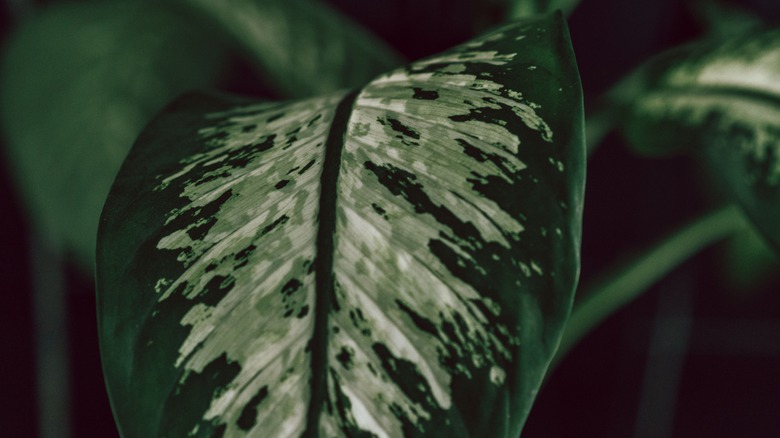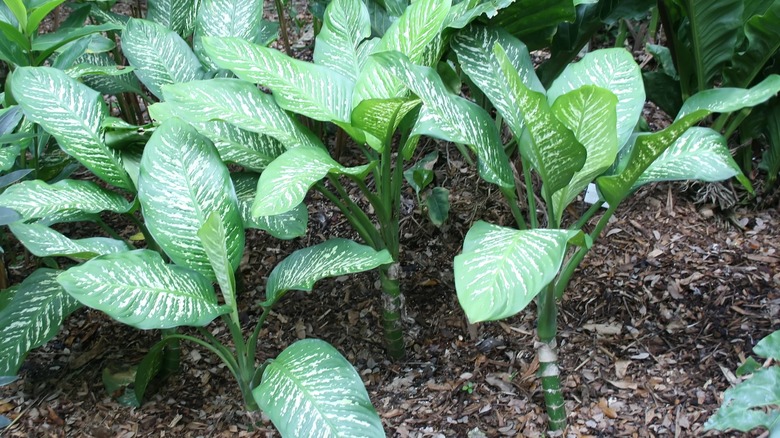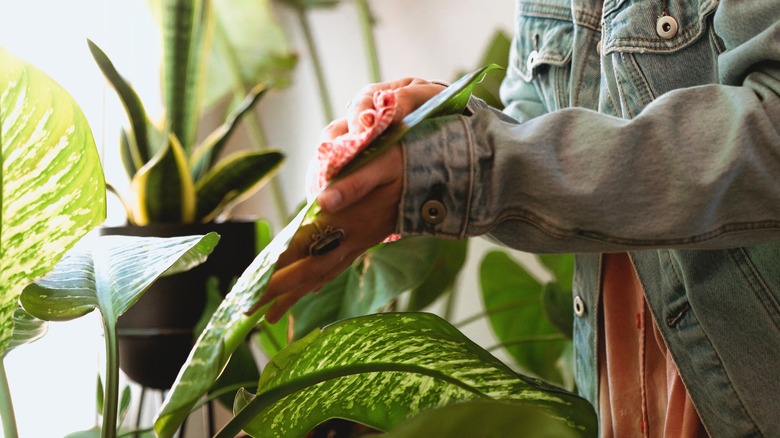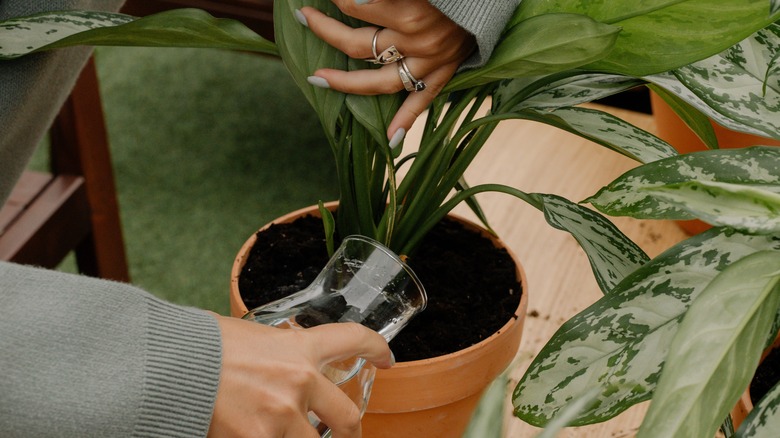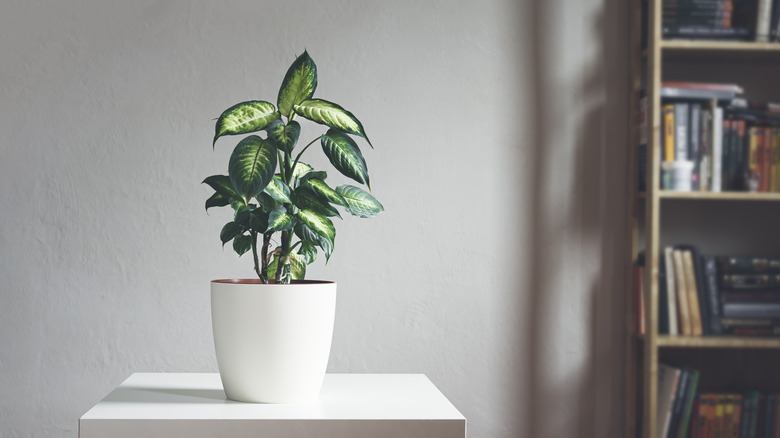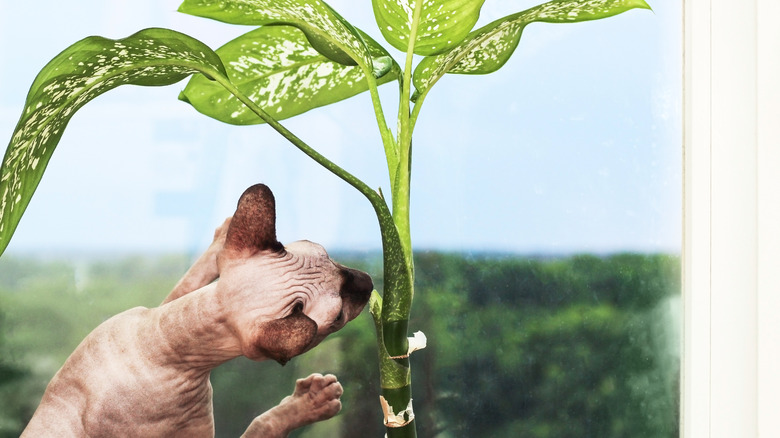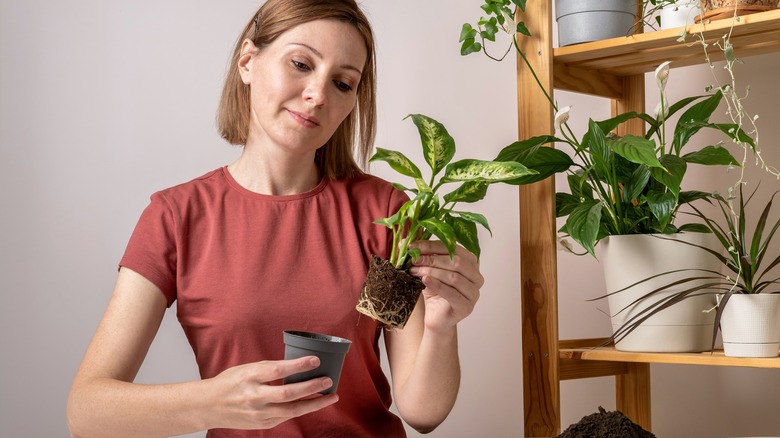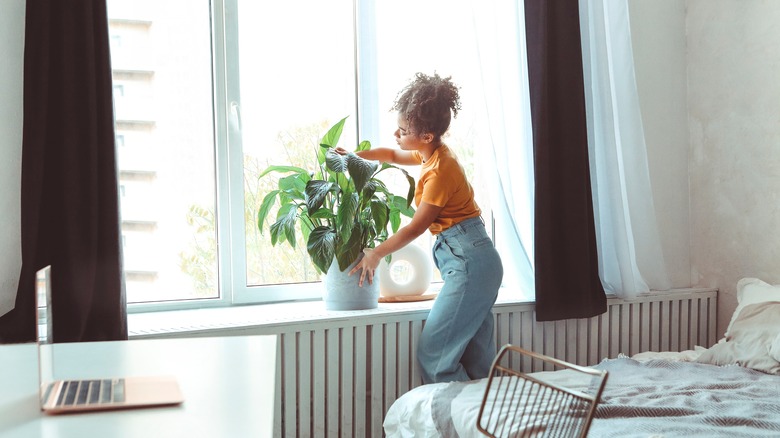How To Successfully Grow A Dieffenbachia Plant
Understanding how to care for a dieffenbachia requires an appreciation for the tropical rainforests of its origin. Known for its splashes of variegation and large leaves, it has transitioned into being a highly prized and popular big-leaf houseplant. When well taken care of, a dieffenbachia rewards you with stunning arrays of white, cream, and yellow variegation on a background of green that ranges from almost neon to deeper, bolder shades.
In its natural habitat, dieffenbachia can grow as tall as 10 feet with 20-inch leaves to match. Indoors, however, it tends to stay a bit shorter, especially with regular maintenance and propagation. The Spruce estimates an indoor dieffenbachia to reach about 2-feet tall after the first year under the proper care.
Like any houseplant, how to care for a dieffenbachia comes down to knowing its preferences. By learning the basics of dieffenbachia care, common problems to look for, and how to maintain it long-term, you will have an eye-catching plant. That beauty sadly comes with a dark history that makes it an important topic of inclusivity in the plant world but a rewarding choice for all plant lovers.
How to use dieffenbachia in garden
Dieffenbachia, an evergreen perennial, is known to grow quickly under ideal circumstances. Although, there is some debate about whether it's an easy or difficult genus to work with, but it's generally considered a great option for indoors. Bloomscape explains its ability to adapt to fluorescent light is one reason it's a popular choice for businesses.
While most commonly grown indoors, dieffenbachia has potential as an outdoor plant. According to Properly Rooted, dieffenbachia does well outdoors in USDA Hardiness Zones 10 through 13. As an outdoor plant, Plant Care Today explains it will grow much like a shrub or become what Planterina describes as a "statuesque small tree" when mature. Crucial to its outdoor care is choosing a spot in your yard that offers cover from direct sun and protection from high-force winds.
Dieffenbachia care depends on whether or not you're in the growing season, which falls between March and October. During this time, plan on increasing the amount of water and light you give your plant, whether indoors or outdoors. This is also the best time to increase the amount of fertilizer or plant food.
How to grow dieffenbachia
While pruning isn't necessary, you should still maintain your dieffenbachia. Plant Care Today recommends removing older leaves as they yellow. This encourages growth, explains Bloomscape, by diverting energy resources to new growth. Aging leaves may fade to brown, which we recommend snipping off.
Dusting dieffenbachia's leaves is the most frequent maintenance task you should be performing. As The Spruce explains, a layer of dust on your plant's leaves will reduce its ability to photosynthesize, causing poor health. How often you clean your plants will depend on your geographical location and the level of dust in the air. With a soft, damp sponge or cloth, wipe the top and bottom of the leaves, always being sure to inspect it as you go. Another option is to move your dieffenbachia into the kitchen or bathroom where you can shower it with the sprayer or shower head. If you do this, be sure to support the leaves to avoid damage.
Repotting is a great time to propagate your dieffenbachia, though Houseplant Help cautions against propagating any plants less than 12 inches tall. With any propagation, use clean, sanitized tools to avoid spreading bacteria when taking a cutting.
How to care for dieffenbachia
Along with understanding general maintenance, there are some basics to know when it comes to caring for dieffenbachia. This genus prefers a well-draining, fertile soil. The Spruce recommends one with a high peat content. Properly Rooted endorses fertilizing dieffenbachia monthly with a balanced NPK fertilizer or plant food. This increases in the growing season when they need more nutrients. Fertilize every two weeks during those months.
Dieffenbachia appreciate bright, indirect sunlight. Too much or too little could cause damage to your plant. It will thrive in average room temperatures. Ideally, you should keep your dieffenbachia at least 60 degrees or warmer.
Any houseplant requires a few watering tips and dieffenbachia are no exception. Let the top 1 to 2 inches of soil dry first. Greenery Unlimited suggests letting it dry more if the plant is kept in lower light. Remember, keep an eye on the leaves; if they appear crinkly or drooping, it's a sign your plant needs water. As a tropical plant, dieffenbachia like a slightly higher humidity level; Planterina recommends about 60%.
Varieties of dieffenbachia
Over the hundreds of years of studying dieffenbachia, many varieties and cultivars have been identified. When shopping for a dieffenbachia, there are a couple of commercial varieties that you will likely come across, according to The Spruce.
The D. seguine is the most popular of the dieffenbachia varieties. It's native to Brazil and characterized by clusters of large, ovate leaves. It's also known for its size, able to grow as tall as 10 feet. D. maculata, formerly known as D. picta, is known primarily for its many cultivars, including 'Perfection,' 'Rudolph Roehrs,' 'Superba,' and 'Camille.'
A larger variety of dieffenbachia is D. amoena, known best for its cultivar 'Tropic Snow.' It was first discovered in Chaplin's Nursery in Fort Lauderdale in 1967, according to Plant Care Today. The Belgian inventor, Edmond J.A. Hollevoet, described the experience of first finding the specimen in Dieffenbachia Amoena cv. 'Tropic Snow' Patent 2,869, saying it "bore variegated leaves ... strikingly different from the leaves of all other dieffenbachia varieties previously known to me."
Is dieffenbachia toxic?
Dieffenbachia is listed as a popular toxic houseplant. The toxicity comes from a nutrient found in many vegetables, but that presents in dieffenbachia as its concentrated form. Plant Care Today tells us the calcium oxalate crystals in the sap and stem can cause irritation. These needlelike crystals release and embed in the soft tissue. If exposed, expect symptoms like burning, difficulty swallowing, excessive drooling, vomiting, temporary speech loss, and possibly suffocation. The Children's Hospital of Philadelphia told Plant Care Today that oxalate crystal poisoning can cause inflammation and severe pain, and can make you feel like you're chewing on broken glass.
Call Poison Control If you suspect a person or animal in your home has ingested any part of your dieffenbachia at 1-800-222-1222. Immediately remove as much of the plant residue as possible and rinse their mouth. Pay attention to the person's condition and immediately take them to the emergency room if they have trouble breathing or swallowing, a common occurrence when dieffenbachia is ingested.
How to repot a dieffenbachia
Caring for a dieffenbachia well means it will grow and you will inevitably need to repot it. Greenery Unlimited recommends basing your repotting needs on the size of your plant, repotting a smaller plant every 12 to 18 months and every 18 to 24 months for larger ones. The Spruce gives a more general recommendation to repot it annually. Regardless, you should wait until spring or summer during the plant's growing season when it will be the strongest. If you aren't sure whether your plant needs to be repotted, use common sense: Does your plant seem to have outgrown its current pot?
Plant Care Today provides an important reminder: Don't overpot. Choose a planter that's a little bigger but not one that's so big you risk the root system suffocating. Choose a pot about 1 to 2 inches bigger than the current one. For larger plants, you can increase the pot size by another inch or so but not more. You should also look for a planter with drainage holes to avoid root rot. Luckily, more of today's trendiest indoor planters are prioritizing function and there are many options to match your aesthetic that also have drainage holes.
The troubling history of dieffenbachia
Dieffenbachia's historical involvement in systemic racism is still evident in its common name: dumb cane. The Hoyt Arboretum explains why the problematic common name still exists, attributing it to the long-term aftermath of colonialism and abuse in botany.
Dieffenbachia was weaponized during the era of slave ownership as a form of punishment. The Independent reports specific mention of Caribbean enslavers engaging in this practice, though it was likely used worldwide. Enslavers rubbed cut stalks of dieffenbachia on the mouths of enslaved people, says the Journal of Ethnopharmacology, causing incredibly painful and sometimes permanent effects of ingesting dieffenbachia, along with the associated temporary speech loss. It was a way of attempting to silence an entire race.
The historical impact of dieffenbachia for Black gardeners is still felt today, especially with the continued use of the common name. Gabrielle Hickmon, a Black gardener, wrote in Zora that gardening is "healing for Black people in a world that often denies us access to greenery, frivolity, healthy food options and full access to our history." To respect all plant lovers, The Wayne Starter puts it as plainly as possible: Since the name dumb cane is harmful and recalls the era of slavery in the U.S., it should be discarded.
